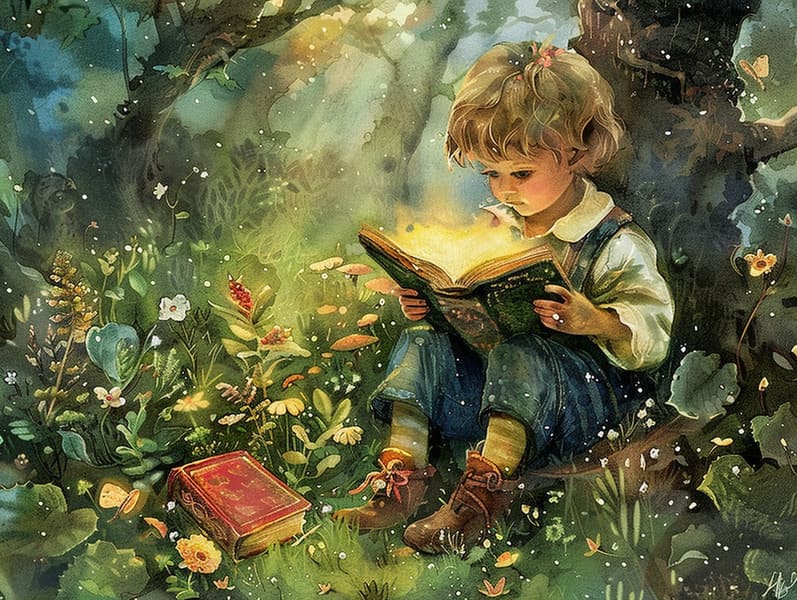The Genesis of Fairy Tales and the Invariable Spell.
The Genesis of Fairy Tales and the Invariable Spell.
Blog Article

Fairy tales for kids have timeless appeal. These tales have been spoken from one generation to the next far before they were ever inscribed. They came from a variety of civilizations, including Eastern traditions. They were initially passed along among elders, often carrying themes and messages related to the societal norms and beliefs of the time.
The renowned Brothers Grimm, Jacob and Wilhelm, were among the first to assemble many of these beloved narratives. Their volume, "Grimm's Fairy Tales," included classics like "The Little Glass Slipper," "Hansel and Grethel," and "Snow-White and Rose-Red," which have since become staples in the world of classic fairy tales. Similarly, Andersen's charming narratives, such as "The Story of the Little Mermaid," and "The Duckling that Could," have captivated hearts worldwide, guaranteeing their place in the pantheon of famous fairy tales.
Despite their age, fairy tales remain as important as ever, especially as children's bedtime stories. These delightful tales are now available in various formats, including artistically illustrated books, captivating animations, and free fairy tales online.
Their enduring popularity can be connected to several magical reasons:
Life Lessons: Traditional fairy tales often convey important moral lessons. Fairy tales like "The Shepherd Boy and the Wolf" teach the significance of honesty, while "The Story of the Tortoise and the Hare" show the virtues of resolve and meekness. These tales offer young readers clear distinctions between moral and immoral, guiding their moral compass in a tender yet meaningful way.
Sympathy and Perception: Fairy tales frequently portray personalities facing challenges and problems, encouraging young listeners to understand with their struggles and boost their triumphs. For instance, "The Story of Beauty and the Beast" emphasizes the benefit of looking past the exterior to know the inner being of a person, enhancing tenderness and knowledge.
Cultural Perception: Many ancient fairy tales are imbued with the cultural contexts from which they emerged. Delving into these fairy tales can provide enlightening views into different ways of life, fostering a sense of world awareness and comprehension.
Inventiveness and Fantasy: The extraordinary elements in old fairy tales—magic wands—activate children’s visions and dreams. These fairy tales lead readers to supernatural realms, revitalizing innovative ideas and a sense of fascination that lasts a lifetime.
Traditional fairy tales are not only charming but also teaching. They serve as alluring tools in strengthening various mind and heart abilities in young readers. When traditional fairy tales are spoken, they boost verbal skills by showing new vocabulary and elaborate sentence structures. This practice also fosters listening abilities and focus, as young ones keep up with the story, enthusiastic to see what happens next.
Furthermore, exploring the themes and characters of fairy tales can promote thinking skills and critical thinking. Little ones are educated to notice patterns, expect results, and grasp cause and effect. These reflections also ease children utter their thoughts and feelings, cultivating their emotional intelligence.
In today’s online age, the prevalence of internet fairy tales has made these stories more accessible than ever. Web platforms and software give vast collections of children's fairy tales that can be looked at or listened on anytime, anywhere. Fairy tales narrated are particularly common, giving an captivating way for kids to relish these fascinating tales. Audio stories and read-out-loud stories carry characters and settings to life, often supported by captivating sound effects and music that enrich the storytelling journey.
The timeless charm of traditional fairy tales lies in their ability to transform to present days while retaining their fundamental ideas. Contemporary modernizations of these stories often integrate more multicultural characters and modern settings, making them understandable to today’s audience. However, the core values of valour, warmth, and equity remain unchanged, continuing to strike a this site chord with listeners of all ages.
Ancient fairy tales also offer a sense of reassurance and knowability. They allow a well-arranged narrative with a straightforward beginning, middle, and end, often concluding with the culmination of conflicts and the triumph of honesty over deceit. This predictability can be reassuring for children, making known a sense of assuredness in an always shifting world.
Traditional fairy tales continue to charm and edify new generations, maintaining their loveliness and meaningfulness in modern society. As kids' bedtime tales, they present a perfect blend of captivation and insight, facilitating moral values, empathy, and creativity. The prevalence of web-based fairy tales and the widespread nature of fairy tales voiced certify that these classic narratives remain available to new generations.
By guarding and disseminating these narratives, we continue to laud the rich tapestry of tales and cultural heritage. Whether you are enjoying a vibrantly illustrated book, discovering a digital library, or listening to an audiobook, the majesty of traditional fairy tales is always within reach. These tales teach us of the invariable nature of fairy tales and its ability to connect us across generations and cultures.
Whether you are seeing a artistically illustrated book, browsing a virtual library, or listening to an audiobook, the captivation of ancient fairy tales is always within reach.
These tales convey of the ageless influence of storytelling and its ability to hold us together across time and space, creating a bond that delights and instructs alike.